In this month’s issue, we release the second part of a Security Overview of Brazil base on data disclosed by the 2023 Brazilian Public Security Yearbook and additional sources. Here, we continue the debate about Brazil’s security conditions by approaching important modifications in the dynamics of property crimes, with the fall of robbery cases and the ascension of frauds and express kidnappings. There is also a dedicate section to discuss the persistent political violence, and other manifestations of violence common in society, like hate crimes; violence against women and in schools.
It is important to recall that the first part of this series was dedicated mostly to violent crimes against life and related topics, which is a quite concerning subject in Brazil’s public security, despite recent improvements. It was presented the most updated scenario of crimes against life, using data about the intentional violent deaths (IVD) by region and by state. Then, we approached the topic of the evolution of the firearms market, which has been in the center of debates about violence. The role of organized crime in the country was also discussed as the main violence driver, followed by the description of areas of special concern due to influence of criminal groups, which continue to expand. In the urban areas, the critical issue of drug consumption and the proliferation of crimes associated was explained, in addition to the negative perspective brought up by new synthetic drugs. Lastly, the general condition of the Brazilian prison system was described, as form of alert to the risks it concentrates.
Summary
Every year, the Brazilian Public Security Forum (FBSP) publishes the Brazilian Public Security Yearbook, which is the broadest portrait of Brazilian public security. Relevant data of crimes perpetrated in all the states are collected, organized and analyzed, producing a unique unified description of the current situation and the ongoing trends in the sector. Based on this document, recently released, and on other additional data, researchers found that, in terms of property crimes, robberies are falling, due to changes in people’s life style. By contrast, the number of frauds and cell phone thefts/robberies increased, particularly, those carried out on the virtual environment. Society’s dynamics have not only influenced property crimes, but also drove other types of crimes that are gaining in scope. It is the case of political crimes, stimulated by the on going political polarization. Here too the digital world plays an important new role of giving an anonymous space to people affiliated to ideologies of hate to connect, discuss the topic, plan and stimulate attacks, like those perpetrated in schools recently.
This Content Is Only For Subscribers
To unlock this content, subscribe to INTERLIRA Reports.
Property Crimes – Robbers Out, Scammers In
According to the 2023 FBSP survey, property crimes statistical data indicates an ongoing strong reconfiguration of offenses committed, especially since the Covid-19 pandemic. For the researchers, criminals began a migration from some modalities to others due to factors imposed by the health crisis. After the end of the pandemic scenario, some transformations were reversed, but some remained.
Robberies and Thefts
Since robberies and thefts depend largely on the flow of people circulating through cities, which was severely restricted by social isolation measures, the number of cases reported of these categories decreased. Crimes involving burglary and home invasion have become more complex for criminals as families started to spend more time inside their homes. In addition, less pedestrians, vehicles and goods were moving, giving less chances for an attack.
By 2022, however, some criminal modalities resumed pre-pandemic trends, with growth in cell phone and vehicle robberies and thefts. Others, however, kept on falling, as is the case of robberies of financial institutions (-21.9%), cargo (-4.4%), commercial establishments (-15.6%), pedestrians (-4.4%) and residences (-13.3%).
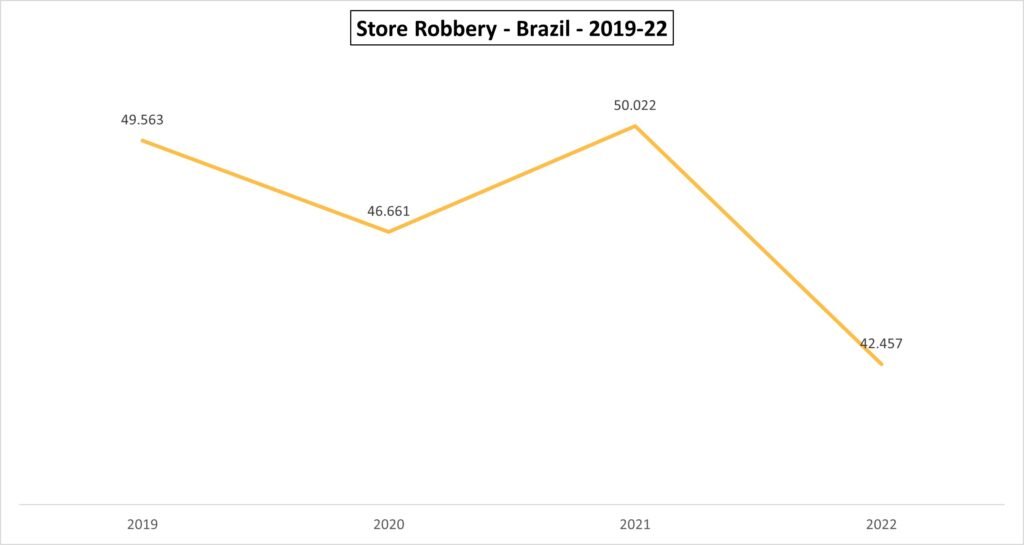
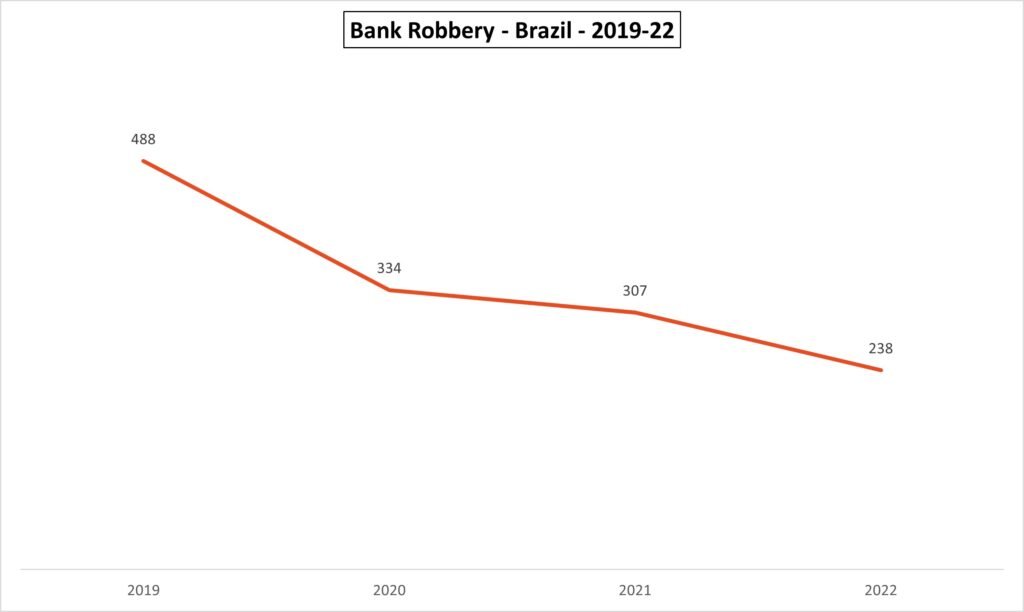

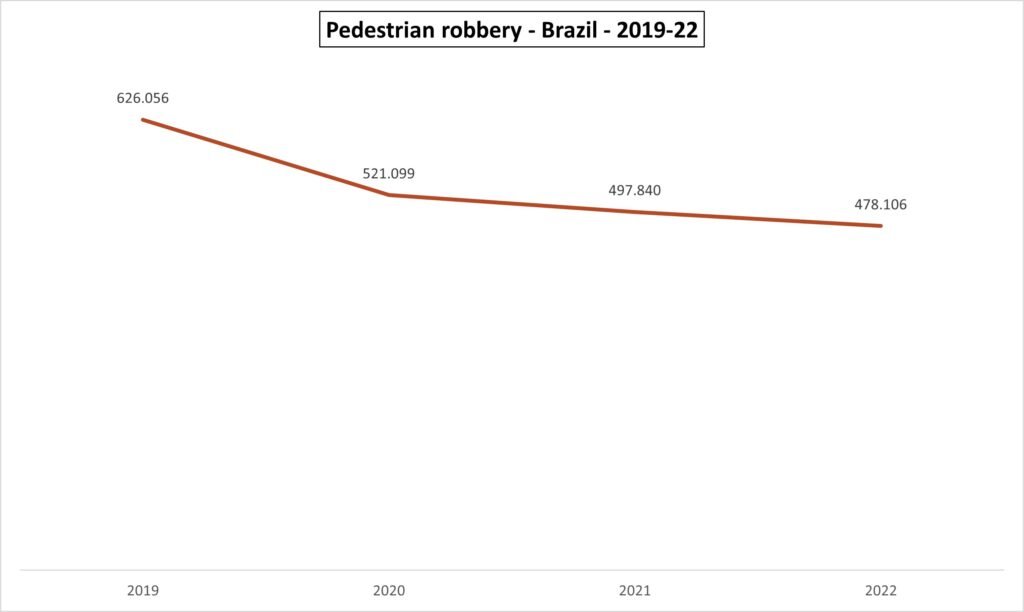
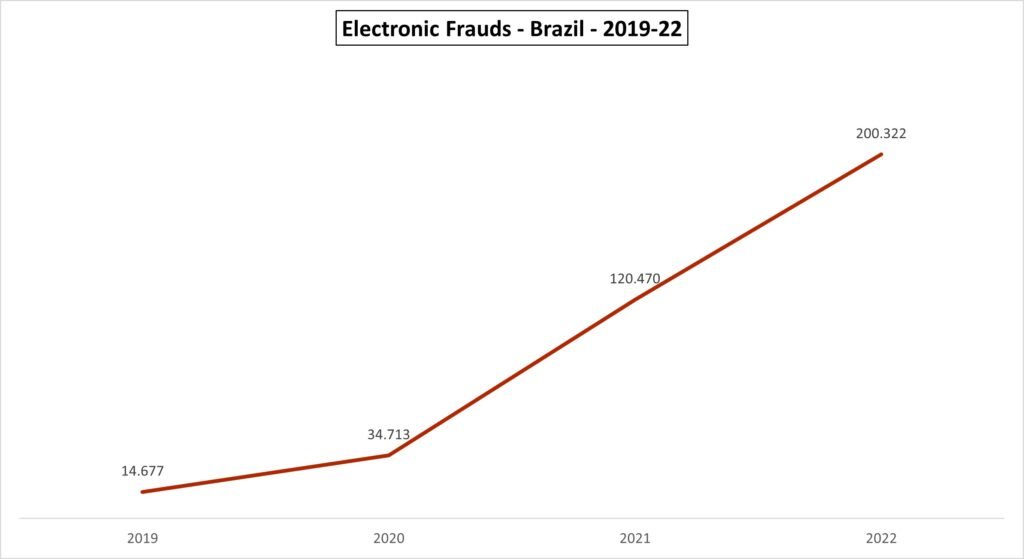
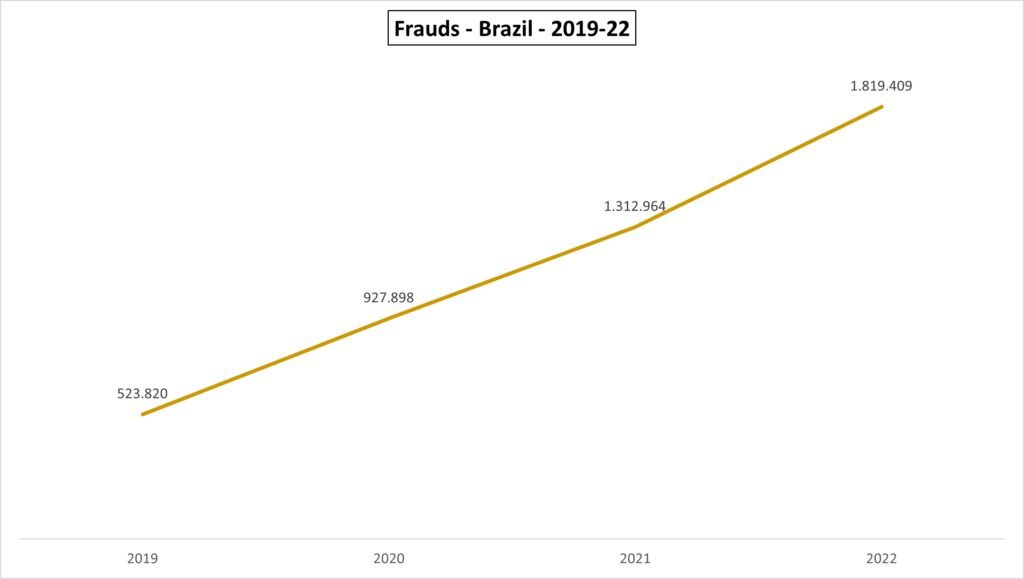

As a consequence of the decrease in the number of these robbery subtypes, the total number of robberies has been reduced. In 2022, it fell by 5.9%, moving from 979,644 cases to 926,423, which resulted in 456.2 robberies per 100,000 inhabitants.
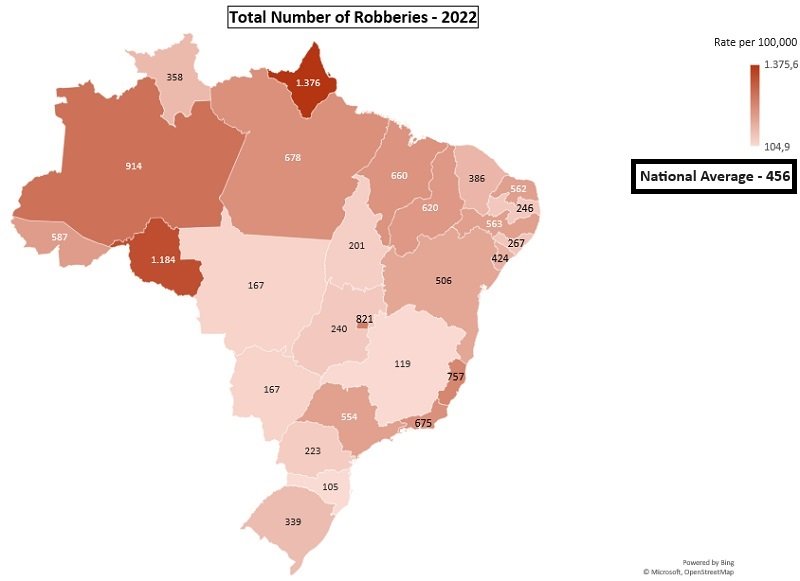
Vehicle Robberies and Thefts
Among the subtypes that reversed are vehicle robberies and thefts. Some of the most concerning types of property crimes in Brazil, particularly the robberies, due to the risk of violence and trauma. In 2022, 373,225 vehicle robberies/thefts were reported in the country. When the social isolation measures were in place, they had a sharp reduction, but grew by 8% in the last year. Despite the increase in 2022, vehicle robbery and theft rates have been decreasing in several Brazilian states for practically a decade, movement attributed to laws that repress the illegal sales of parts removed from stolen vehicles. A lack of regulation of this commerce online can hamper the improvements seen in past years. Most incidents are thefts (60.3%) – with no violence involved –, which represents a good factor, but stresses the need to properly protect vehicles – and the belongings they carry – when parked.

Cell Phone Robberies and Thefts
Another category that reversed the decrease seen in the pandemic period was cell phone robbery and theft, which records amassed 999,223 occurrences throughout the country in 2022. This represents a growth of 16.6% in relation to the previous year. Furthermore, from 2018 and 2021, numbers show that most cases are robberies – on average, 56.5%. Even though in 2022 this difference fell, the result indicates as modus operandi, the criminals use violence or the threat of violence as a major method for taking the device from their victims.
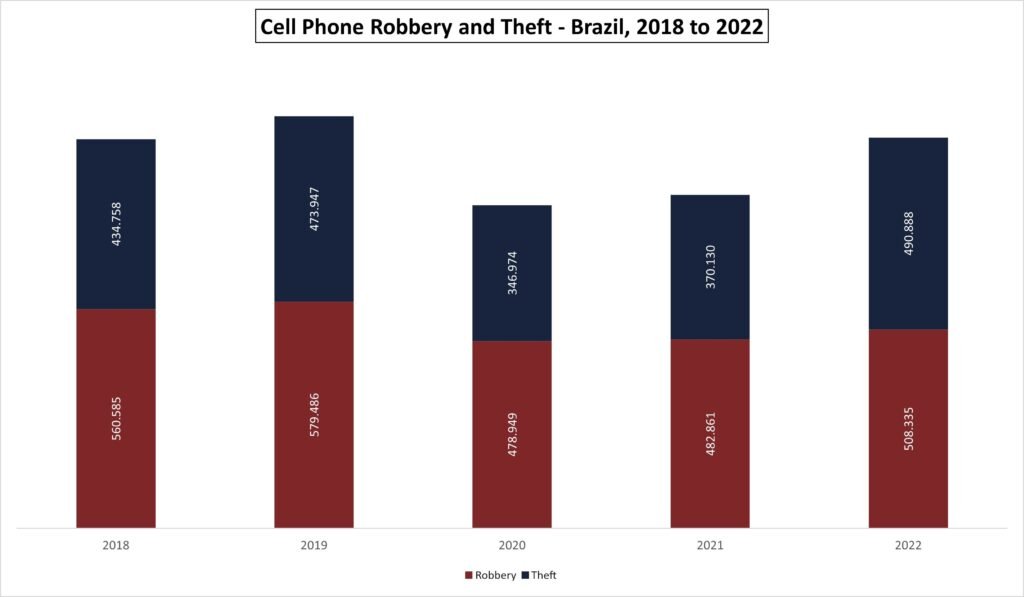
For the experts, the reason behind this reversion is the central role cell phones now play in society. The devices are a multifunction tool, with which people communicate, work, carry personal documents, complete financial transactions etc. And this was exacerbated by the limitations imposed by the health crisis. Thus, seeing that the social isolation measures disrupted the world of crime, increased risks and limited opportunities of gains with the usual offenses, criminals noticed that cell phones theft was an excellent alternative. Phones can be sold, dismantled for the parts and, if unlocked, could give access to profiles, e-mails, personal data, bank accounts and more.

Once inside the bank apps, criminals can transfer all the money. However, possibilities are even greater, because they are able to perpetrate a series of scams, passing themselves as of the victim, and ask money from friends and infiltrate their accounts, get loans, and use personal data inside the phone to many other tricks.
Scams
In 2021, electronic frauds became so popular that authorities had to add it to the law. In 2022, 200,322 occurrences were recorded, an increase of 65.2% in relation to 2021. But the real picture may be worser as available data exclude five of the most populous Federation Units in the country (BA, CE, RJ, RS and SP) and Rio Grande do Norte.

Criminals took advantage of social changes. In 2019, 74% of the population had access to the internet, in 2021, this changed to 81%. In the same period, the number of internet users that acquired a product or a service online moved from 39% to 46%.
Still, anything that could bypass the “isolation factor” created by the pandemic was also an alternative, thus, all types of scams went up. In 2019, a pre-pandemic year, 523,820 cases were recorded. In 2022, this total reached 1,819,409, a 247% increase. The number is equivalent to an average of 207.7 cases registered per hour in the country. Between 2021 and 2022, the growth in fraud records was around 37.9%.
Express Kidnappings
Numbers provided by police forces of some states in Brazil indicate that express kidnappings have surged in the past few years. Even though the FBSP keeps no national records of this type of crime, by using the considerations made about the forces moving up the number of cell phone thefts and robberies, it is possible to conclude that the same factors likely influenced cases of express kidnappings. Furthermore, the implementation of the PIX, a new, simpler and much faster method of financial transaction, has probably played a part in this.
For instance, in São Paulo, the number of kidnappings reached the highest level in 15 years. There were 165 registrations from January to September 2022, an increase of 75% compared to the first three quarters of the previous year (94 notifications). And the number already exceeds the entire year of 2021 (160 cases). In Rio de Janeiro state, the increase was also strong, cases rose by 75% from 2021 to 2022. The total moved from 113 to 198 cases.

Other modus operandi for kidnappings have drawn attention. They are a variation that uses dating apps to attract victims. A date is scheduled, and the meeting location is where the person will be kidnapped. According to São Paulo Public Security Secretariat (SSP), more than 90% of the kidnappings registered in São Paulo are made from relationships apps.
Political Violence, Hate Crimes, Violence Against Women and More
In addition to the property crimes, and the gang violence, Brazil suffers with a series of other issues that have increased and causing concern among authorities, like political violence, hate crimes, violence against women, violence in schools and others.
Political Violence
In 2022, the country had one of its most disputed presidential elections. The ideological clash escalated, and under extreme political polarization, episodes of violence exploded. According to the work Political and Electoral Violence in Brazil, 266 cases of political violence were reported last year. This is the highest result reported since 2016, when the continuous survey began. Among the total there were nine assassinations, 25 attempted murders, 96 threats, 63 aggressions, 65 offenses and others. Cases reported month by month show that incidents tend to increase near the elections.
Politicians are the main target of the episodes of violence, particularly city councilors. In order to control this scenario, authorities prepared new laws against this type of crime. On 24 July, a bill was sent to the Federal Chamber to toughen the penalties for crimes against the democratic rule of law, including increasing the penalty to 40 years in prison for those who attempt against the life of politicians.
Violence in Schools
Another type of violence that emerged and has been gaining importance due to consecutive new attacks are the attacks in schools. A survey carried out by the Sou da Paz Institute points out that within six months, 2023 has already the highest number of attacks in Brazilian schools at least since 2002. Since then, 25 incidents have been registered, seven of which in 2023. The previous record was achieved in 2022, with six cases. Before that, in 2019, there were three attacks inside educational institutions. The cases seem to be growing each year.
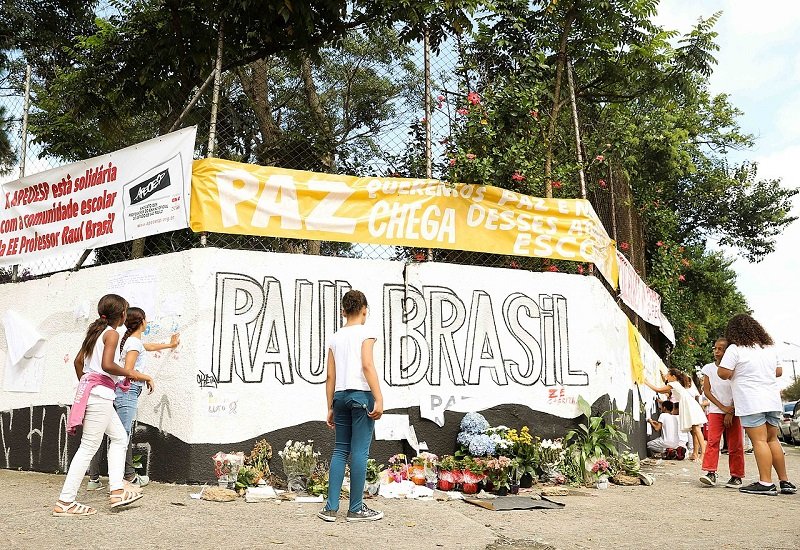
Moreover, the FBSP points out that, during a survey with principals of schools all over Brazil, 1,295 said to have had episodes of shootouts and stray bullets in 2021.
The Federal Government took a series of measures to contain the cases. A group of experts was created to begin developing a national policy against violence in schools. R$ 150 million were provided to reinforce school patrols. It was announced that staff will be trained to mediate conflicts. 40 new officers were added to a team that monitors online environments for threats.
Hate and Sexual Crimes
Police investigations found that many of the attacks in schools are incentivized through online forums and some social networks, where a lot of content with hate speech is published. For instance, in July, investigations found groups in Discord and TikTok that promote content involving sexual exploitation; pedophilia; self-mutilation; racism; animal abuse; incitement to murder; and violence against minorities, homosexuals, women etc.
The issues observed online are a new manifestation of what happens on the streets in the form of crime. In 2022, the FBSP found that there was an increase of 35% in cases of racism and of 29.9% in crimes of racial offense. Racisms due to homophobia or transphobia went up by 53.6%, and violent assaults against LGBTQI+ people rose by 13.4%.
Despite various initiatives to contain violence against women, like the Maria da Penha Patrol, many indicators got worse. The number of feminicides increased by 6.1%, amassing a total of 1,437. Sexual harassment had a 49.7% increase, and 6,114 cases reported. Still, the result that stood out was the record in the number of rapes, 74,930 were recorded, the biggest result ever seen, and an 8.2% increase in comparison to 2021, especially because it is known that violence against women is largely under reported.




